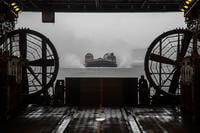At the height of its Reagan-era expansion, the U.S. Navy had nearly 600 warships. Now, the fleet is now down to 296 warships -- the smallest size since before World War I, the San Diego Union-Tribune says.
Don't expect the fleet to get any bigger any time soon. The Navy says it will only have 300 ships by 2009.
THERE'S MORE: Defense Tech pal JP gives this fleet-reduction issue some historial perspective:
First, a smaller fleet has often historically proven to be a more effective one. Before the First World War, Admiral Jackie Fisher improved the quality of the Royal Navy by drastically slashing the number of warships in commission -- mostly cruisers on foreign station. He did so over howls of protest, dismissing the older ships he was scrapping as "a miser's hoard of useless junk" that in wartime a single modern enemy cruiser would "lap up, like an armadillo on an anthill." (...)
Older warships have historically been less capable than newer ones (this is, I think, less true now than formerly, because we've gotten better at upgrading them with better sensors, electronics, and weapons-control software, but it's still more-or-less the case) and they tend to be very expensive to operate... It becomes difficult to maintain them, old steam plants are more expensive to run than new gas turbines, parts are no longer available, wiring harnesses reach the limits of their ability to accept upgrades, etc. (...)
Second, missions do change, and warships tend to be optimized for some particular mission. The guided missile frigates in the fleet today, for example, were conceived and built as escorts needed to keep the sea lines of communication open between North America and Europe. That was a very sensible thing to plan for in the Cold War.
Today, with the old Soviet fleet basically rusting to nothing, and with no other large blue water [open ocean] navy out there to challenge us, it's not clear that we need a lot of frigates. They're still useful and versatile ships, which is why we'll continue to run them through the end of their useful lives, but the Navy doesn't intend to replace (them)...
Destroyers like the Arleigh Burkes are new, modern, and versatile, so they'll be around longer, and will continue to be built until the Navy figures out what should replace them.
If you were to try to summarize the change in the Navy's mission and strategy over the last ten years, you could say that the Navy now sees its primary mission as expeditionary power projection (as opposed to either sea control or nuclear deterrence, which preoccupied it before).
This means that it has to think more about striking land targets (hence the conversion of some Ohio class subs into cruise missile platforms), putting Marines ashore and supporting them there (hence the interest in shallow water anti-sub warfare, mine countermeasures, fast sea lift, and littoral operations generally), and maintaining a sovereign presence to support US operations around the world (which means, for now, a continued emphasis on nuclear-powered big-deck carriers, and, for the future, "sea-basing" that will reduce our dependence on various shady and shaky panjandrums and potentates willing to provide bases).
As the missions and strategies shift, there will inevitably be a number of ships retired as no longer really useful -- Fisher's miser's hoard of useless junk. There's an inevitable gap, I think, as any Navy figures out what new kinds of ships are needed to accomplish the new missions. You can see the Navy working this out pretty publicly right now.
AND MORE: Gregg Easterbrook examines the Littoral Combat Ship -- "pretty much the first American vessel in more than a century intended to hold coastal areas and bombard shore emplacements" -- and how it might be used off the shores of Africa and elsewhere.
AND MORE: Defense Tech reader DS disagrees with JP's historical analysis. British Admiral Jackie Fisher wasn't out to improve quality, per se, when he cut the number of cruisers before WW I. He did it "because the British needed the money and men to build and man the dreadnoughts they were building."
At the turn of the century, "better engines, better guns, better metallurgical techniques (which meant better armor) were all appearing on the scene... In 1905, (Fisher) decided to put all the innovations together in a single ship, which he hoped to have floating within the year... The ship that the British built, the Dreadnought, was everything that Fisher hoped for and more. It was fast, powerful, and heavily armored. It made, at a stroke, all other battleships obsolete."
But to pay for these new beasts, Fisher had to scrap the British cruisers.







